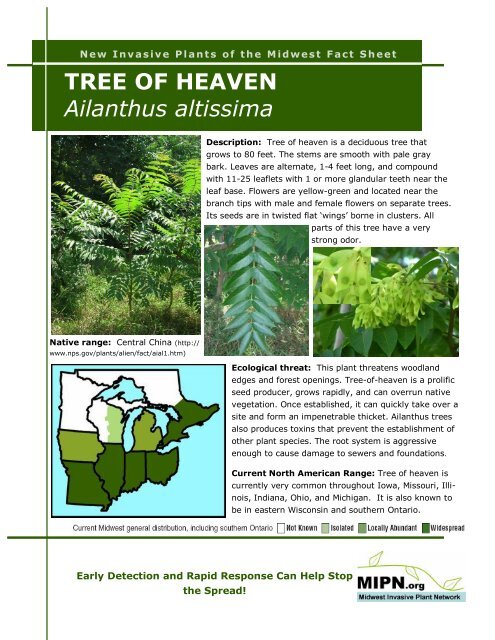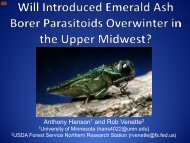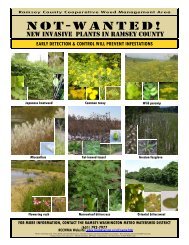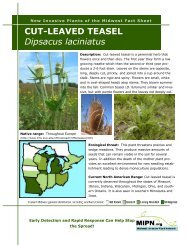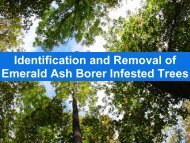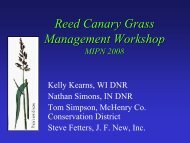TREE OF HEAVEN Ailanthus altissima - Midwest Invasive Plant ...
TREE OF HEAVEN Ailanthus altissima - Midwest Invasive Plant ...
TREE OF HEAVEN Ailanthus altissima - Midwest Invasive Plant ...
You also want an ePaper? Increase the reach of your titles
YUMPU automatically turns print PDFs into web optimized ePapers that Google loves.
New <strong>Invasive</strong> <strong>Plant</strong>s of the <strong>Midwest</strong> Fact Sheet<strong>TREE</strong> <strong>OF</strong> <strong>HEAVEN</strong><strong>Ailanthus</strong> <strong>altissima</strong>Description: Tree of heaven is a deciduous tree thatgrows to 80 feet. The stems are smooth with pale graybark. Leaves are alternate, 1-4 feet long, and compoundwith 11-25 leaflets with 1 or more glandular teeth near theleaf base. Flowers are yellow-green and located near thebranch tips with male and female flowers on separate trees.Its seeds are in twisted flat ‘wings’ borne in clusters. Allparts of this tree have a verystrong odor.Native range: Central China (http://www.nps.gov/plants/alien/fact/aial1.htm)Ecological threat: This plant threatens woodlandedges and forest openings. Tree-of-heaven is a prolificseed producer, grows rapidly, and can overrun nativevegetation. Once established, it can quickly take over asite and form an impenetrable thicket. <strong>Ailanthus</strong> treesalso produces toxins that prevent the establishment ofother plant species. The root system is aggressiveenough to cause damage to sewers and foundations.Current North American Range: Tree of heaven iscurrently very common throughout Iowa, Missouri, Illinois,Indiana, Ohio, and Michigan. It is also known tobe in eastern Wisconsin and southern Ontario.Early Detection and Rapid Response Can Help Stopthe Spread!
<strong>TREE</strong> <strong>OF</strong> <strong>HEAVEN</strong>, <strong>Ailanthus</strong> <strong>altissima</strong>MANAGEMENT OPTIONS: (http://www.nps.gov/plants/alien/fact/aial1.htm)Elimination of <strong>Ailanthus</strong> requires diligence, due to its abundant seed production, high seed germination rate,and vegetative reproduction. Followup monitoring and treatment when needed should be an integral part ofany serious ailanthus management program. Regardless of method selected, treated areas should be recheckedone or more times a year and any new suckers or seedlings treated (cut, sprayed or pulled) as soon as possible,especially before they are able to rebuild root reserves. Establishing a thick cover of trees (preferably native,and non-invasive) or grass sod will help shade out and discourage establishment of ailanthus seedlings. Targetinglarge female trees for control will help reduce spread of ailanthus by seed.Mechanical methodsYoung seedlings may be pulled or dug up, preferably when soil is moist. Care must be taken to remove the entireplant including all roots and fragments, as these will almost certainly regrow. Root suckers appear similar toseedlings, but would be connected to a pre-existing lateral root, and would be nearly impossible to remove effectively.Cutting alone is usually counter-productive because ailanthus responds by producing large numbers ofstump sprouts and root suckers. However, for small infestations, repeated cutting of sprouts over time can exhaustthe plants reserves and may be successful if continued for many years or where heavy shade exists. Ifpossible, the initial cutting should be in early summer in order to impact the tree when its root reserves are lowest.Cutting large seed producing female trees would at least temporarily reduce spread by this method.Chemical methodsFoliar sprays applied when trees are in full leaf are very effective, and should be the method of choice whereailanthus size and distribution allow effective spray coverage of all foliage without unacceptable contact withnearby desirable vegetation or applicator. Where ailanthus is in association with other exotic weed species, as isoften the case, foliar spray allows treatment of the entire area at one time. Limitations of the method are theseasonal time frame, the need to transport a larger, more diluted volume of spray material, and the fact thatrapid growing ailanthus are often out of effective reach.Basal bark application is one of the easiest methods and does not require any cutting. It works best during latewinter/early spring and in summer. The base of the tree stem must be free of snow, ice, or water on the barkfrom recent rainfall, though precipitation following application is inconsequential. Late winter/early spring(February 15-April 15, Mid-Atlantic) is generally the most productive time, since vegetation near the base of thetrees is usually absent or leafless. Late spring and early summer applications (April 15-June 1, Mid-Atlantic),when plant fluids are moving upwards to support new growth, are questionable. Application during the summer(June 1-September 15, Mid-Atlantic) works very well as long as vegetation is not a hindrance, and allows lowerconcentrations of herbicide to be used. Fall to mid-winter applications (October-January) have given poor results.The hack-and-squirt or injection method is very effective and minimizes sprouting and suckering when appliedduring the summer. Root suckering will be an increasing problem in the fall, winter and spring.The cut stump method is useful in areas where the trees need to be removed from the site and will be cut aspart of the process. While situations exist that dictate this method over the others given above, felling trees isusually less effective in killing the root system, slower, more labor intensive, and more hazardous to personnelthan other methods. This method is likely to be most successful during the growing season, with diminishingsuccess through the early fall.For more information on control and management of this species, please visit the following Web sites:www.usda.plants.gov, www.nps.gov/plants/alien/factmain.htm, tncweeds.ucdavis.edu/comtrol.html, dnr.wi.gov/invasives/plants.htm, www.invasivespeciesinfo.gov/plants/main.shtml, http://www.nps.gov/plants/alien/fact/pope1.htmEarly Detection and Rapid Response Can Help Stop theSpread!


